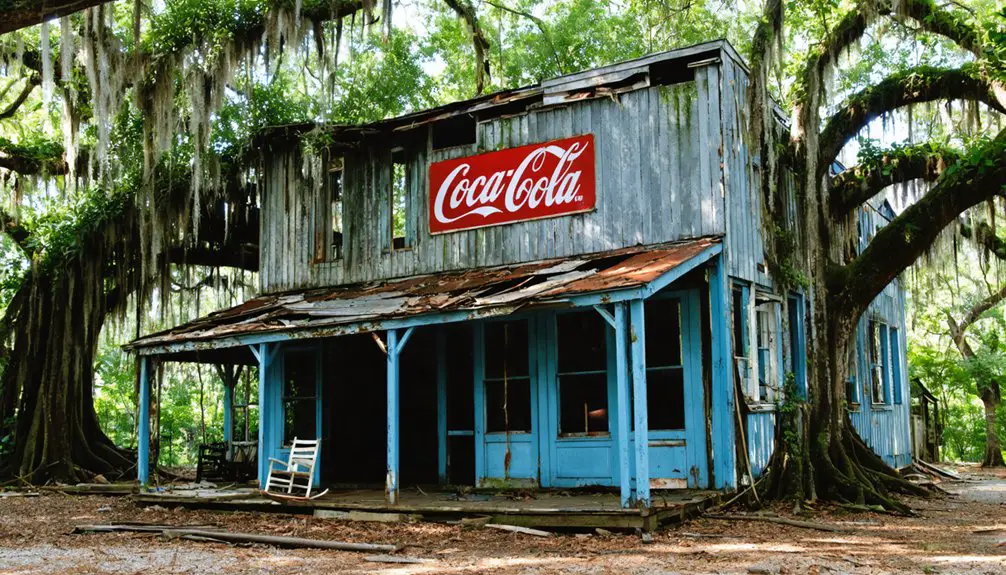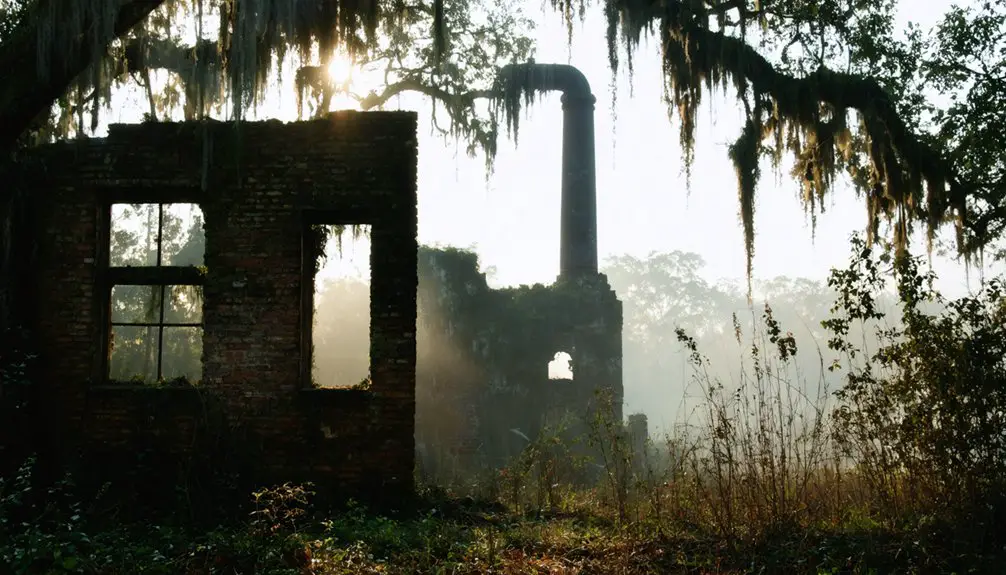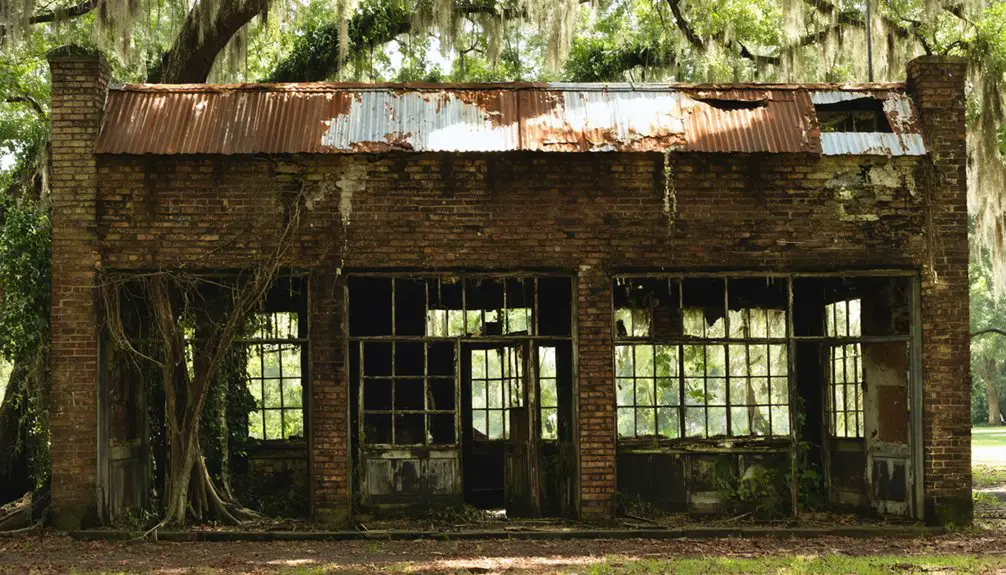You’ll find the remnants of Haile ghost town at the historic Kanapaha Plantation site in modern-day Gainesville, Florida. The once-thriving 1,500-acre Sea Island cotton plantation, established in 1854, centered around a 6,200-square-foot Greek Revival mansion that still stands today. After the Civil War and an 1868 crop failure, the plantation fell into decline and abandonment. The mansion’s mysterious “Talking Walls,” containing over 12,500 words, hold secrets of its fascinating past.
Key Takeaways
- Haile was a thriving plantation community established in 1854 that declined into abandonment after the Civil War and 1868 cotton failure.
- The area’s economic downfall led to Thomas Haile’s bankruptcy, causing the once-prosperous plantation community to gradually disperse.
- The Haile Homestead stood abandoned and deteriorating for nearly 40 years until its rediscovery by University of Florida students in 1986.
- The remnants of the former plantation community include the preserved 6,200-square-foot Haile Homestead and its famous “Talking Walls.”
- Local development has since revitalized the area, though the original plantation community qualifies as a ghost town due to its abandonment.
The Rise of Kanapaha Plantation
When Thomas Evans Haile and his wife Serena Esther relocated from Camden, South Carolina to Alachua County, Florida in 1854, they established the expansive 1,500-acre Kanapaha Plantation.
The plantation’s origins trace back to their redirected journey – originally bound for Missouri, they changed course and chartered a schooner in Charleston toward Florida’s promising frontier. You’ll find they purchased land from the Arredonda grant at just $1.25 per acre.
The Hailes’ fateful detour from Missouri to Florida’s frontier marked the beginning of Kanapaha Plantation’s remarkable story.
Their initial success with Sea Island cotton, a premium long-fiber variety, attracted more family members to the Kanapaha area. Thomas Haile’s success made his mother the richest woman in Alachua County.
With 56 enslaved African Americans constructing the homestead over 18 months, the plantation quickly became a significant agricultural operation. The completed homestead would later gain recognition for its unusual wall writings, with family members documenting their daily lives directly on the walls.
Despite early prosperity, economic challenges would later emerge, particularly following the Civil War‘s devastating impact on the Southern plantation system.
Architecture of the Haile Homestead
Standing as one of North Central Florida’s largest antebellum structures, the Haile Homestead showcases a remarkable blend of architectural styles across its 6,200 square feet.
You’ll find Greek Revival elements in the transom windows and porch columns, while the high-pitched roof reflects Florida’s vernacular “cracker” design, purposefully engineered for the Southern climate.
The foundation rests on four-foot limerock piers with 100-foot beams, built by skilled enslaved craftsmen including stonemason Henry Gaines. The plantation’s original Sea Island cotton operations influenced the home’s spacious design and layout. The home remained dormant since 1930s until its rediscovery revealed the unique interior features.
The interior features 12-foot ceilings and the famous “Talking Walls,” where you’ll discover over 12,500 writings dating to the 1850s.
Enslaved artisans like Billy Watts and Johnson Chestnut brought exceptional carpentry skills to the pine and cypress construction, creating an enduring representation of antebellum design that’s earned its place on the National Register of Historic Places.
The Mystery of the Talking Walls
Among America’s most intriguing historical records, the Talking Walls of Haile Homestead contain over 12,500 words inscribed directly onto the interior walls by generations of the Haile family.
Starting in 1859, you’ll find everything from cryptic messages like “THE HOUSE WAS BRIEFLY ALIVE” to children’s growth charts, recipes, and party guest lists spanning over a century.
The inscription significance extends beyond mere family connections, offering unique insights into plantation life, slavery, and post-Civil War society.
These historic wall inscriptions serve as rare windows into the complex social fabric of the American South’s tumultuous transformation.
During a 2001 restoration, workers discovered additional hidden writings beneath plaster layers. The enslaved laborers constructed the home in 1856 under the direction of Thomas and Serena Haile. The walls tell intimate stories through poems, business records, and daily observations – creating an unparalleled archive of Southern life.
Today, these remarkable inscriptions have helped secure the homestead’s place on the National Register of Historic Places. Visitors can explore this unique historical site through weekend guided tours that reveal the fascinating stories behind each inscription.
Life During the Plantation Era
In 1854, Thomas and Serena Haile transformed Florida’s wilderness into the sprawling Kanapaha Plantation, bringing 56 enslaved people from South Carolina to establish their 1,500-acre cotton enterprise.
The plantation’s success relied entirely on enslaved labor, with skilled craftsmen like Billy Watts, Henry Gaines, and Johnson Chestnut forced to construct the 6,200-square-foot main house using pine and cypress. Today, the historic structure stands as one of the few remaining antebellum homes in North Central Florida. The home’s distinctive talking walls contain over 12,500 words written by family members and visitors over the years.
While the Haile family lived in their grand homestead, the enslaved community endured life in small, one-room frame houses away from the main house. They toiled in the Sea Island cotton fields and maintained the plantation’s infrastructure.
Though Thomas Haile prospered as one of the region’s wealthiest planters before the Civil War, his fortune crumbled with the 1868 cotton crop failure, leading to bankruptcy.
The Roaring Parties of the 1900s
If you’d visited Haile during its social heyday of the early 1900s, you’d have found yourself immersed in lavish Gatsby-style parties where jazz music filled plantation homes until dawn.
Wealthy locals and out-of-town guests would dance the Charleston and other popular moves of the era, while bootlegged liquor flowed freely despite Prohibition’s restrictions.
The revelry left its mark in guest books and even on walls, where partygoers sometimes inscribed their names, creating lasting evidence of these roaring celebrations that defined Haile’s social scene. Much like the jazz music revival of the era documented in the History Center’s “Decade of Change” exhibition, these parties captured the spirit of the Roaring Twenties.
The historic property, which first opened to visitors in 2001, now serves as a window into both the glamorous parties and the complex history of the plantation era.
Dancing Until Dawn
While the walls of Haile Homestead stood silent during daylight hours, they came alive with the sounds of music and laughter during the plantation’s legendary dance parties of the early 1900s. You’d find Mrs. Rachel Haile chaperoning these social gatherings, where multiple generations swayed to the rhythms of the era.
The dance traditions, preserved in over 12,500 words scrawled across the home’s “Talking Walls,” reveal how these parties continued through the 1930s.
You can trace the evolution of Southern aristocratic life through these inscriptions, where formal celebrations merged with the exuberant spirit of the Roaring Twenties.
Even young Ben Haile, at age seven, left his mark on these walls, capturing moments of joy against the backdrop of changing times.
Guest Book on Walls
Anyone visiting the Historic Haile Homestead today can marvel at the remarkable “Talking Walls” – an expansive collection of over 12,500 inscriptions that transform the home’s interior into a living guest book.
You’ll discover personal messages that span decades, capturing guest interactions from the 1850s through the vibrant party era of the early 1900s.
- Original wall inscriptions date back to 1859, starting with Benjamin Haile himself.
- Weekend gatherings filled every room with witty poems, recipes, and social commentary.
- Each wall in social spaces contains over 150 distinct messages.
The wall inscriptions range from practical household inventories to humorous quips like “If love be cold, don’t despair, there’s always flannel underwear.”
You’ll even find detailed records of significant events, including the harsh freeze of January 1886.
Gatsby-Style Social Scene
The grand walls of Haile Homestead didn’t just record guests’ messages – they captured the spirit of an era marked by sophisticated soirées and weekend revelry during the early 1900s through the 1930s.
You’d find yourself amid lively dances and croquet matches, where party etiquette blended seamlessly with playful flirtation and witty repartee.
Within the pine-and-cypress mansion’s spacious rooms, social hierarchies softened as guests inscribed poems, jokes, and observations on the walls.
Under the watchful eyes of chaperones like Mrs. Rachel Haile, impromptu dances broke out while children and adults alike contributed to the home’s unique “talking walls.”
The 1,500-acre estate provided an exclusive backdrop for these gatherings, where Southern tradition met modern excitement in a celebration of life’s carefree moments.
Abandonment and Rediscovery

After serving as a prominent plantation home since 1856, Haile Homestead gradually fell into disuse and abandonment during the early 20th century.
The abandonment causes included economic shifts, the family’s move to town, and changing social structures that made maintaining a plantation home impractical.
For nearly four decades, the historic structure stood silent and deteriorating.
You’ll find these fascinating details about the property’s rediscovery significance:
- University of Florida architecture students uncovered the forgotten treasure in 1986
- Over 12,500 words and drawings were found preserved on the “Talking Walls”
- The discovery led to National Register of Historic Places recognition and restoration efforts
Today, you can explore this cultural landmark that captures both antebellum history and the unique personal expressions of its former inhabitants.
Preserving a Historical Legacy
Preservation efforts at Historic Haile Homestead showcase a unique partnership between the Alachua Conservation Trust and Haile Family Trust, who jointly manage this 6,200-square-foot antebellum plantation home.
The site’s historical preservation centers on its remarkable “Talking Walls,” containing over 12,500 words and drawings from the 1850s to early 1900s.
You’ll find strong community engagement through weekend tours and educational programs that tell the complete story of the plantation, including the lives of enslaved people who lived there.
The University of Florida‘s architecture students contribute to ongoing research and restoration projects, while specialized conservation techniques protect the home from Florida’s challenging climate.
Local development taxes and nonprofit support through Historic Haile Inc. guarantee this rare piece of North Central Florida’s heritage remains accessible for future generations.
Haunted Tales and Local Legends

You’ll find some of North Florida’s most compelling ghost stories within the Haile Homestead’s “Talking Walls,” where cryptic messages like “THE HOUSE WAS BRIEFLY ALIVE” remain unexplained since their 19th-century origins.
Local legend tells of weekend party guests who mysteriously vanished after social gatherings, their presence now felt only through detailed wall inscriptions describing dances and celebrations from the 1800s.
The dense layers of personal messages, spanning over 12,500 words and drawings, have led paranormal investigators to suggest the walls themselves might serve as a spiritual portal, preserving echoes of both the Haile family and the enslaved people who lived there.
Mysterious Vanishing Party Guests
While the Haile Homestead’s “Talking Walls” document thousands of genuine messages from party guests, local lore tells darker tales of visitors who mysteriously vanished during social gatherings at the plantation.
You’ll find these ghostly anecdotes deeply woven into the fabric of local paranormal culture, sparked by the property’s complex history of social stratification and isolation.
The plantation’s haunted reputation has only grown stronger through generations of oral traditions and unexplained phenomena during modern-day tours.
- Vanishing guests were often reported during weekend parties that featured dances and hunts.
- The plantation’s antebellum past and Civil War era created a perfect backdrop for mysterious disappearances.
- Local ghost societies continue marking the homestead as a hotspot for supernatural activity.
Eerie Wall Message Origins
Despite popular ghost stories surrounding the Haile Homestead’s “Talking Walls,” their true origins stem from practical nineteenth-century habits rather than supernatural sources.
The wall inscriptions began in 1859 when young Benjamin Haile made the first dated marking, setting off a unique tradition that would span generations.
You’ll find over 12,500 words scrawled throughout the home, created by family members, visitors, and weekend party guests who needed a place to write when paper wasn’t handy.
The historical significance of these markings lies in their raw authenticity – from mundane household inventories and recipes to playful poetry and personal observations.
What started as a practical solution became an extraordinary chronicle of daily life, capturing everything from rat-catching tales to flirtatious party notes between 1859 and the 1930s.
Frequently Asked Questions
What Happened to the Enslaved People After the Civil War Ended?
Many freed slaves stayed local, working as sharecroppers or hired hands. You’ll find that some, like William Watts, purchased their own land, while others built new communities and attended schools like Union Academy.
Are Descendants of the Haile Family Still Involved With the Property Today?
Yes, Haile descendants remain actively involved through the Haile Family Trust, which co-owns the homestead with Alachua Conservation Trust. They help preserve the family legacy through site management and cultural heritage activities.
How Many Rooms in Total Does the Haile Homestead Contain?
While you’ll find this historically significant plantation home spans 6,200 square feet, exact room counts aren’t documented in official records, though the complex room layout suggests there are more than a dozen spaces.
What Methods Are Used to Preserve the Wall Writings From Deterioration?
You’ll find careful preservation techniques protect these whispers from the past through climate control, UV filtering, protective coatings, air filtration, and restricted access to prevent physical damage to wall writings.
When Did the Last Permanent Residents Leave the Haile Homestead?
You’ll find the last permanent residents left the historically significant homestead in the early 1930s, when the house was boarded up, leaving behind resident stories preserved through their “Talking Walls” writings.
References
- https://www.clickorlando.com/features/2024/09/21/briefly-alive-this-old-florida-home-is-full-of-strange-messages-and-mysteries/
- https://www.youtube.com/watch?v=XSRqh2mQVKo
- https://www.fmofm.com/stories/the-haunting-of-haile-house
- https://www.tripadvisor.com/Attraction_Review-g34242-d4156486-Reviews-or10-Historic_Haile_Homestead-Gainesville_Florida.html
- https://theclio.com/entry/20099
- https://www.thejaxsonmag.com/article/the-historic-haile-homestead-the-talking-walls/
- https://gainesvillelife.com/haile-plantation-gainesville/
- http://www.kanapaha.net/page/page/1404009.htm
- https://en.wikipedia.org/wiki/Haile_Homestead
- https://www.hmdb.org/m.asp?m=70202



